The story of one ship
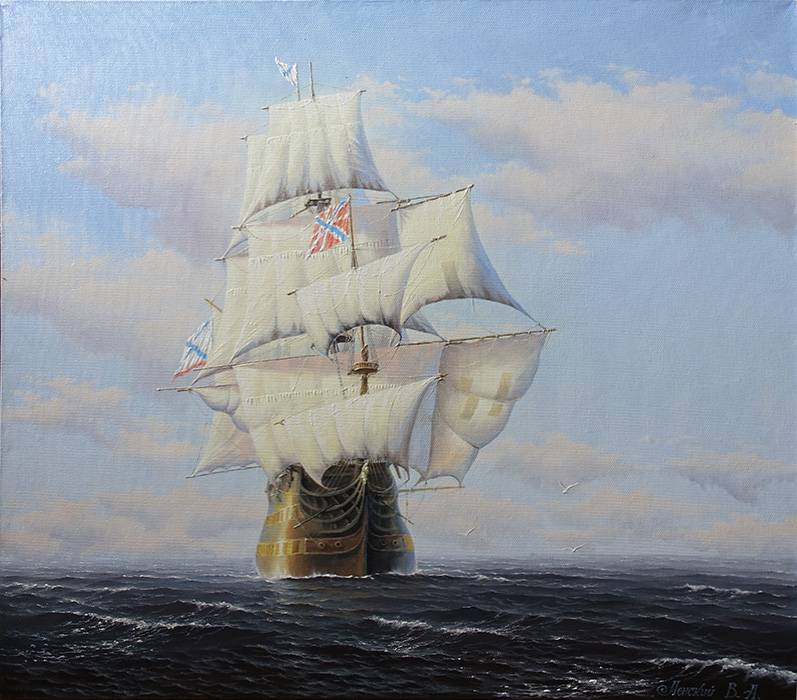
September 27 marks the 240th anniversary of the commissioning of the 66-gun sailing battleship “The Glory of Catherine,” which was later renamed “Transfiguration of the Lord.” "Slava Ekaterina" became the first battleship of the Black Sea fleet and left a wide mark in Russian stories. Let's talk about the history of this ship and generally touch on the complexities of Russian shipbuilding on the Black Sea at the end of the XNUMXth century.
So, in 1778, the construction of the Kherson shipyard began, and this was proposed by the English admiral Charles Knowles, hired for Russian service. The point was the following - up to this point, Russian ships were built either in Taganrog or in Voronezh, on the Don River. Both the Sea of Azov and the Don had very shallow depths, and this imposed a limitation on the size of ships. The organization of the shipyard in the Dnieper-Bug Estuary made it possible to begin the construction of larger ships.
Initially, the first project of a battleship for the Black Sea was developed by an English shipbuilder in Russian service, Lambe Yames; he proposed building 60-gun ships with a length of 47,2 meters, a width of 12,55 meters and a draft of 4,8 meters, which gave approximately 0,3 meter of reserve under the keel for passage into deep water.
In 1780, Yames worked out a project for the construction of a 66-gun ship with slightly increased dimensions (48,8x13,5x5,8 m), and on July 7, 1780, shipwright Semyon Ivanovich Afanasyev at the Kherson shipyard laid down two 66-guns in “good proportions.” cannon ships - “The Glory of Catherine” and “St. Paul”.
A government decree of 1781 ordered the construction of 12 such ships, but in 1784 it was decided to have ten 66-gun ships and two more powerful 80-gun ships. By the beginning of the Russian-Turkish War of 1787–1791, five of the ten 66-guns had been built.
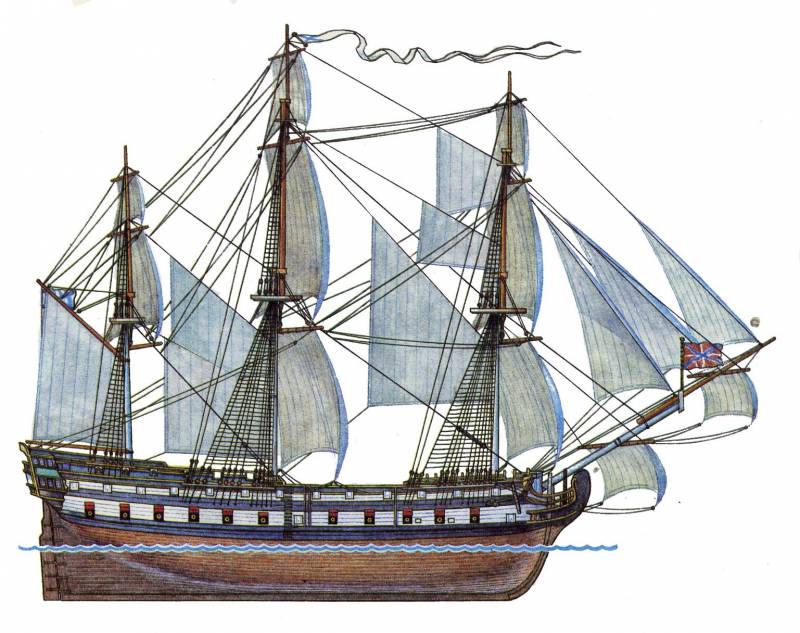
View of the ship "Glory of Catherine"
Afanasyev proposed a rather bold solution: “On the Black Sea, sailing from one’s shores at a short distance, provisions and other supplies are not only half, but even a third of those in St. Petersburg are enough, and therefore the local ships can be built much sharper-bottomed, which are more convenient for sailing than the current ones, and there are storms on they will withstand the sea more reliably".
Initially, Polish oak, purchased in 1779, was used for construction, but then, according to a letter from Lieutenant Rzhevsky to Count Chernyshev dated May 11, 1783, two events occurred at once that suspended the construction of the ship: Poland banned the circulation of Russian banknotes and copper coins in the country, as well as Plague appeared in the area where forests were harvested. Therefore, it was urgently necessary to find reserves and fill the lack of forest with Crimean oak.
Plus, the plague soon reached Kherson, so as of July 19, 1782, according to the report of Lieutenant General Hannibal, no more than half of the work on the ship “Slava Ekaterina” had been done. However, the plague soon receded, work was continued, and on July 19, 1783, a captain, Marko Voinovich, was appointed to the ship.
Well, on September 27, 1783, the “Glory of Catherine” entered service with the Russian Black Sea Fleet. It was retrofitted for about a year, and only on September 4, 1784, the ship went to sea without guns for transportation to Akhtiar Bay (future Sevastopol).
On September 6, the Russians passed Ochakov, and seven days later the ship dropped anchor at the southern tip of Crimea. There, guns were installed on the ship, rearmed and finally equipped; its armament consisted of twenty-six 30-pounder guns on the lower deck, twenty-six 12-pounder guns on the middle deck and sixteen 6-pounder guns on the upper deck and superstructures. On July 25, 1785, the Glory of Catherine conducted its first exercises at sea with other ships of the squadron.
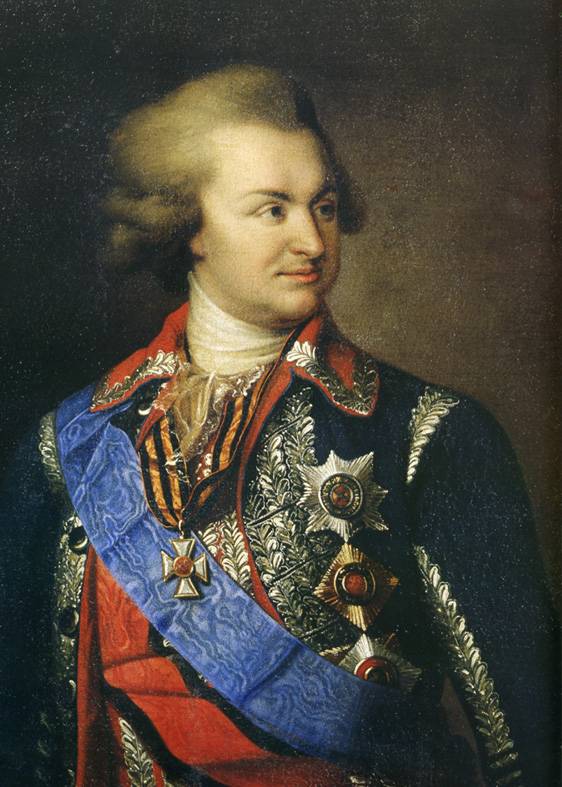
Prince Grigory Alexandrovich Potemkin
In the list for 1786 there are three 66-gun ships “The Glory of Catherine”, “St. Paul" and "Mary Magdalene" are considered "reliable", that is, capable of swimming.
With the outbreak of the Russian-Turkish War at the end of the summer of 1787, the “Glory of Catherine”, as part of almost the entire Black Sea squadron, went to sea in order to search for the Russian fleet near Varna. On September 9, 1787, off Cape Kaliakria, the squadron was caught in a storm that lasted five days. As a result, the ship was left with only a foremast, it was carried away to the Caucasian coast, and only on September 22, having installed false masts, Voinovich was able to return to Sevastopol.
From Voinovich’s report to Rear Admiral Mordvinov: “It’s a miracle, Nikolai Semyonovich, how we were saved, you can’t believe our misfortune, and how everything was skimped on in one hour: the ships and frigates became like a sieve, there was a terrible leak and my ship almost sank.”.
In this situation, the Russians temporarily only had the Azov squadron of 4 frigates left at sea, and the entire Sevastopol detachment was undergoing repairs in Sevastopol. And this despite the fact that masts and timber had to be transported from Poland to Kremenchug, and then floated down the Dnieper.
"The Glory of Catherine" was very damaged. From Voinovich's report to Potemkin: “the hull of the ship moved along and across in the grooves and at the joints of the decks”, the beams and knuckles came out of their sockets, the waterways came off on all the decks, the steering wheel was badly damaged, and so on, so on, so on. The repairs were headed by shipwright Katasanov, who arrived from Arkhangelsk.
It is clear that the ships of the Sevastopol squadron were repaired with all possible speed, but meanwhile the first naval battle of that war, Ochakovskoe, was unfolding in the Dnieper-Bug estuary. Here the Liman flotilla and Kinburn's coastal batteries distinguished themselves, which inflicted serious losses on the Turks.
On March 13, 1788, according to the rescript of Prince Potemkin, the ship “Glory of Catherine” was renamed “Transfiguration of the Lord”, and “hereafter stood under that name”.
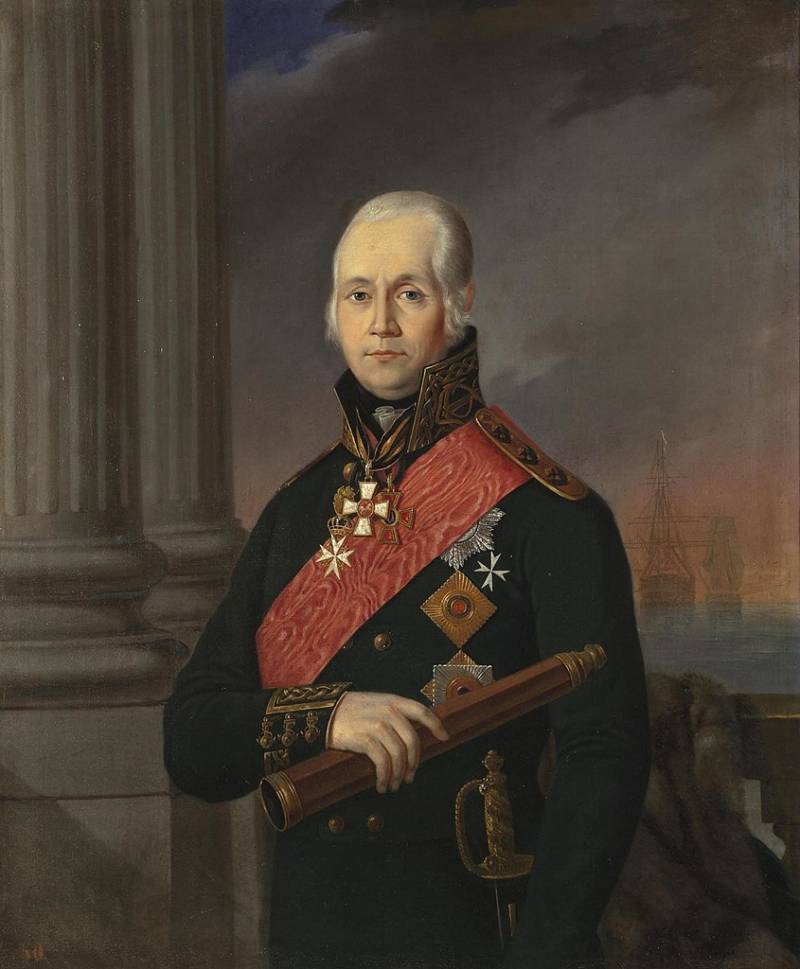
Fedor Fedorovich Ushakov
On June 18, 1788, the Transfiguration of the Lord, being the flagship in Voinovich’s squadron, went to sea along with other ships. The main task of the Russian squadron was to prevent the Turkish squadron, which fled after the defeat near Ochakov, from returning again and providing assistance to the Turkish troops besieged in Ochakov.
Due to nasty winds, the Russians approached the Tendrovskaya Spit only on July 10. On July 14, a firefight between the Russian and Turkish squadrons took place near Zmeiny Island (Fidonisi), which ended without result for both sides. The Russians insist on sinking one shebeka; according to Turkish data, they had no losses in the battle.
On July 19, the squadron returned to Sevastopol.
Then the fleet was headed by Ushakov, but throughout 1789 there were no battles as such - the fleet strengthened its composition.
In 1790, for their operations, the Turks pulled almost their entire fleet into the Black Sea - a Turkish squadron under the command of Hussein Pasha entered the sea. Its composition was 17 battleships, 5 bombardment frigates, 23 small vessels. The ships carried troops to Crimea - according to various sources, from 3 to 7 thousand soldiers. Depending on the situation, they planned to land either in Kerch, and if the coastal defenses there were strongly fortified, then in Kuban, in Anapa. Composition of the Turkish squadron:
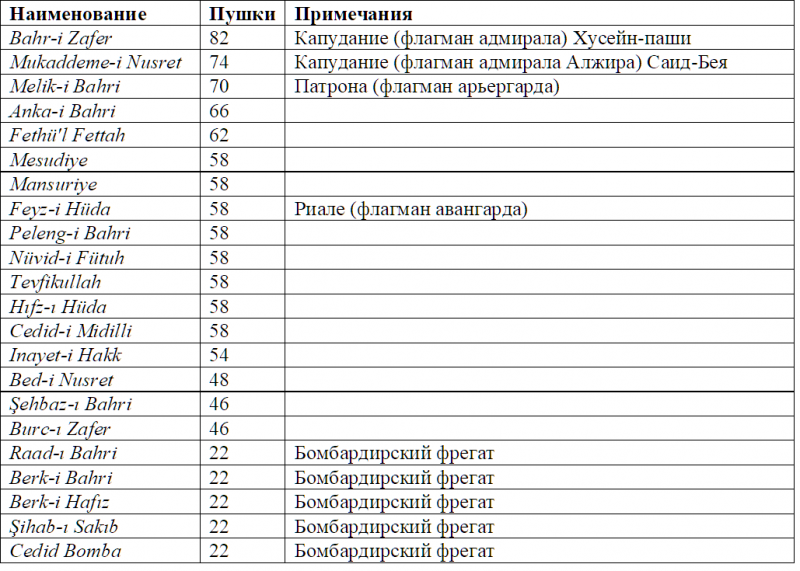
Composition of the Turkish fleet at Kerch
On July 8, Ushakov went to sea, having 10 ships in service (84-gun "Nativity of Christ", 66-gun "Mary Magdalene", "St. Paul", "Transfiguration of the Lord", "St. Vladimir", 50-gun " Apostle Andrew", "Alexander Nevsky", "George the Victorious", 46-gun "Peter the Apostle" and "John the Evangelist"), 6 frigates (40-gun "Jerome", "Nestor the Rev.", "Protection of the Virgin", "John Militant", "Ambrose of Milan", "Kirill Belozersky") and 17 small ships (860 guns in total).
On July 19, 1790, the Battle of Kerch took place. Ushakov weighed anchor and ordered to build a line, the Turks gybed and moved parallel to our squadron to the southeast. The firefight took place over a fairly long distance - 600-800 yards, both sides behaved cautiously.
The Turks, taking advantage of the windward position, began an attack on the vanguard around noon, but the ships of the center arrived in time and together were able to repel the attack.

Kerch battle
Neither the Turks nor the Russians had any losses in ships. After the Kerch battle, Ushakov had 29 killed and 68 wounded. The number of casualties among the Turks is unknown, but most likely they were greater than the Russians, since the ships carried troops, in addition to the ship’s crews.
After the battle, Hussein Pasha took his squadron to the Tendra Spit, thereby cutting off Sevastopol from Nikolaev and Kherson, where ships were being built, and threatened the Russian army operating in the Danube and Dniester area, slowing down the movement of troops to Kiliya and Izmail until mid-September. Ushakov had to give one more battle to the Turkish fleet in order to secure the flanks of the army and relieve Ochakov, Kherson and Nikolaev from a possible threat.
The Russians completed repair work in Sevastopol on August 19, but went to sea only on September 4 with the same composition: 10 ships, 6 frigates, 1 bombardment ship, 17 cruising ships. The Turks also had no changes in the ship's composition, only Said Bey moved his flag from the Mukkadem-i Nusret, which was badly battered near Kerch, to the 58-gun Mansurie.
At 6 o'clock in the morning on September 8, Ushakov discovered Hussein Pasha's fleet 7 miles away, anchored in three lines. Realizing the low fire value of the Russian frigates, which were weakly armed, he separated “Jerome”, “Protection of the Virgin” and “John the Warrior” into a separate detachment, with the task of providing assistance to the main forces in difficult areas in close combat.
At 15:00, the Russians caught up with the Turks, and brutal shooting began from both sides, and Ushakov escalated the situation by ordering to approach the Turkish ships to 50 fathoms (about 100 meters). By 17:00 the Ottomans could not stand the close combat and began to leave the line. The Russians set off in pursuit and pursued the enemy until darkness, being forced to anchor at sunset.
At dawn the next day it turned out that the Turkish ships were in close proximity to the Russians, and the Russian ships were generally scattered over a large area. The Turkish fleet was divided into two large parts - the northern, led by “Bahr-i Zafer” (flag of Hussein Pasha), and the southern, with the flagship “Melek-i Bahri” and “Mansurie” (flag of Said Bey).

Battle of Tendra Spit
If the unit led by Hussein managed to escape unhindered to the shoals of Hajibey near the Dniester and take refuge there, then the southern group of ships was not lucky. Ushakov attacked her with all his might, there was no talk of any line anymore, the Turkish ships set off scattered, and the Russian commander focused his attention on the two largest ships - the Melek-i Bahri and the Mansurie. The first was damaged in yesterday's battle (lost part of the foremast) and could not reach the required speed, the second was trailing, as befits a flagship.
At 10:00 the 50-gun Apostle Andrey caught up with the Mansurie and entered into battle with it. Soon the same type of "George the Victorious" joined the shelling of the wounded man, and 20 minutes later the 66-gun "Transfiguration of the Lord" attacked the unfortunate Turk from the other side. Half an hour later, the flagship 84-gun "Nativity of Christ" took over the Mansurie. A fire broke out on the Turkish ship, the fire reached the crew chamber, an explosion occurred, and the Mansurie disappeared in a blinding flash.
As for Melek-i Bahri, he also resisted until the last opportunity. By 14:00 it was already surrounded, Russian ships, replacing each other, planted cannonballs into the motionless, without masts, flagship of the Algerian squadron. The approaching “Rozhdestvo Khristovo” stood on its side to the bow of the “Melek-i Bahri”, intending to fire a longitudinal salvo, and Said Bey ordered to surrender. Later the ship was brought to Sevastopol, repaired and put into operation under the name "Leonty Martyr".
The Turks lost two ships in this battle.
On July 31, 1791, another battle took place between the Russian and Turkish fleets, in which the Transfiguration of the Lord took part - the battle at Cape Kaliakria. Here our 66-gun ship took part in shelling the Turkish 74-gun ship Mukkaddime-i Nusret from long range. Many Turkish ships were damaged, but neither the Turks nor the Russians had any losses in the battle.
In December of the same year, Russia and Türkiye made peace.
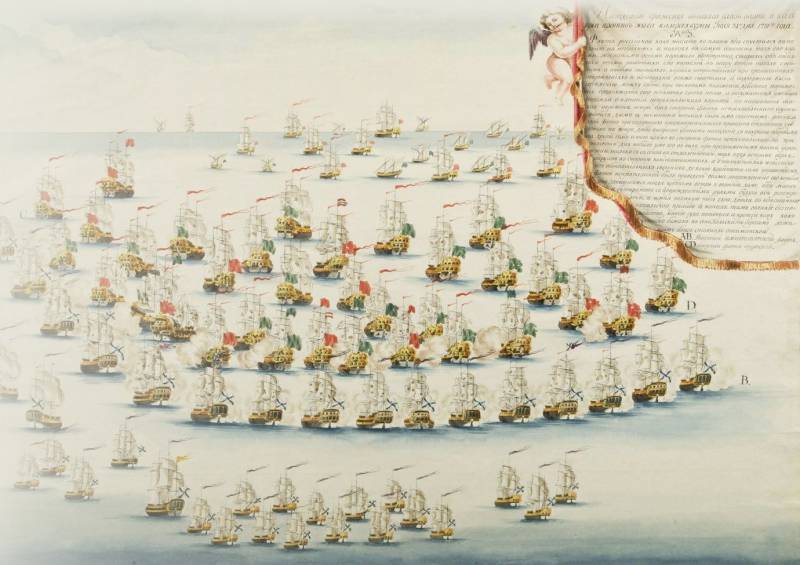
Battle of Kaliakria
“Transfiguration of the Lord” briefly survived the war; in 1794 it was declared “incapable” and scrapped. Thus, the ship served 7 years of active service. Is it a lot or a little?
According to the report of the Forestry Commissioners of England and the Colonies, published in 1792, the average life expectancy of ships built for the Royal Navy from 1760 to 1788 was 11 years and 9 months.
At the same time, ships built from colonial wood had a lifespan of 3 years 6 months. From the Baltic - 8 years 3 months. From English – 10 years 4 months.
Thus, even if compared with this parameter, the “Transfiguration of the Lord” was built conscientiously and honestly served those seven years of active, no fools, service, with battles and storms, for which it was built.
The first-born of the Russian Black Sea Fleet turned out to be a successful ship, and this is a credit to the Russian shipbuilders of the century of Catherine and Prince Potemkin.
References:
1. Veselago F. F. “Materials for the history of the Russian Fleet” - St. Petersburg: Printing house of the Maritime Ministry, 1895. - T. XV / “Documents of the Black Sea Fleet from 1783–1796.”
2. Sozaev E. Tredrea J. “Russian Warships in the Age of Sail 1696–1860: Design, Construction, Careers and Fates” - Seaforth Publishing, 2010.
3. Anderson, R. C. “Naval Wars in the Levant 1559–1853” - Princeton: Princeton University Press, 1952.
4. Tevfik Temelkuran “Gazavat-ı Cezayirli Gazi Hasan Pasha” – İstanbul University, 2000.
5. Emir Yener “Ottoman Seapower and Naval Technology during Catherine II's Turkish Wars 1768–1792” – International Naval Journal. – 2016. – Vol. 9. – No. 1.
Information